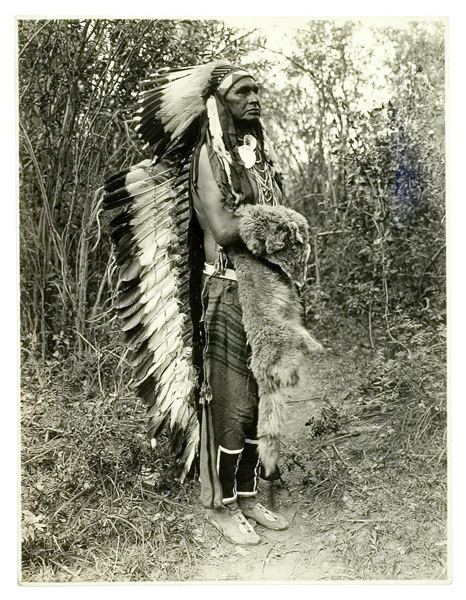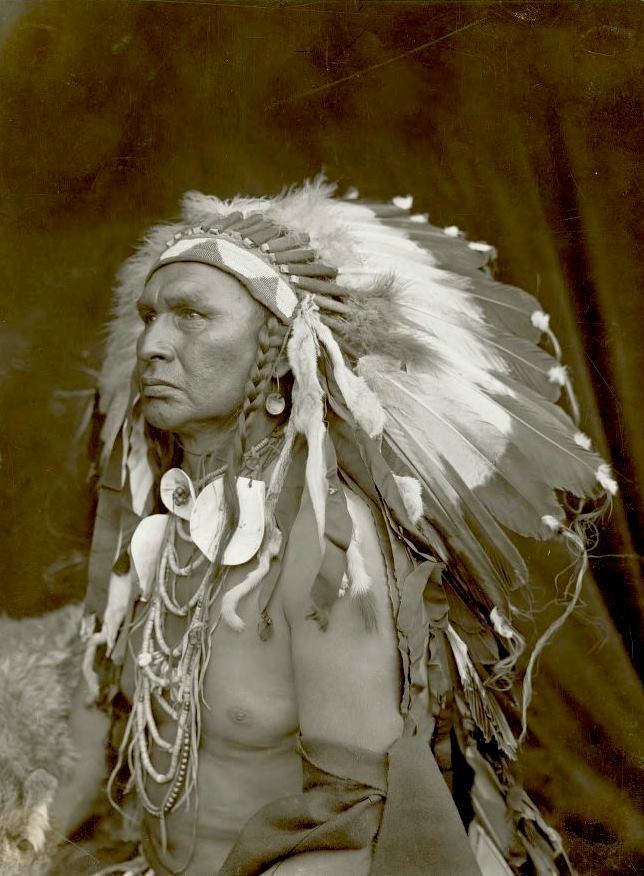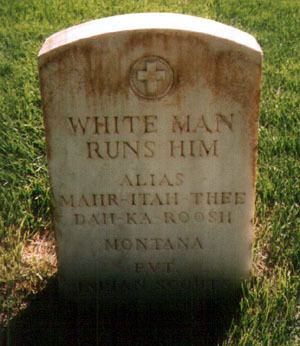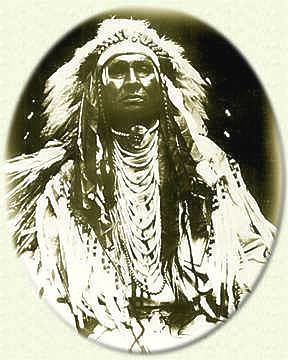Name White Runs | Died June 2, 1929 | |
 | ||
Spouse(s) Pretty Medicine Pipe, d. Apr. 2, 1943 Relations Stepgrandfather of Joe Medicine Crow; grandfather of Pauline Small; great-grandfather of Janine Pease Parents Bull Chief, Offers Her Red Cloth Nickname(s) White Buffalo That Turns Around Similar People Joe Medicine Crow, George Armstrong Custer, George Crook, Sitting Bull, Crazy Horse | ||
white man runs him
White Man Runs Him (Mahr-Itah-Thee-Dah-Ka-Roosh; c. 1858 – June 2, 1929) was a Crow scout serving with George Armstrong Custer’s 1876 expedition against the Sioux and Northern Cheyenne that culminated in the Battle of the Little Bighorn.
Contents

Dr. Joe Medicine Crow Speaks
Early life

Also known as White Buffalo That Turns Around, he was born into the Big Lodge Clan of the Crow Nation, the son of Bull Chief and Offers Her Red Cloth. At the age of about 18, he volunteered to serve as a scout with the United States Army on April 10, 1876, in its campaign against the Sioux and Northern Cheyenne, traditional enemies of the Crow.
Service as a scout

White Man Runs Him "enlisted on April 10, 1876 at the Crow Agency, Montana Territory, for six months in the 7th United States Infantry." On June 21, 1876, he was transferred to Custer’s Seventh U.S. Cavalry as part of a contingent of six Crow warrior/scouts, including Goes Ahead, Curly, Hairy Moccasin, White Swan, and Half Yellow Face, the leader of the scouts. He scouted for Lt. Charles Varnum’s column in the days preceding the battle. In the early morning hours of June 25, 1876, he and other Crow scouts accompanied Varnum and Custer to the Crow’s Nest, a high point on the Little Bighorn/Rosebud Creek divide, from which the Little Bighorn valley could be viewed at a distance of about seventeen air miles. The scouts could see indications of a large horse herd and the smoke of many morning fires, though the encampment itself was hidden from view on the valley floor. The Crow scouts advised Custer that the encampment was very large. Custer prepared to attack, however. Custer was concerned that during the morning of June 25, Sioux/Cheyenne warriors had detected the presence of his 650-man force, and if he did not promptly attack, the villagers would scatter, thus denying the army the confrontation it sought with the Sioux/Cheyenne forces.

Convinced they were about to die in battle, the scouts took off their uniforms and donned Crow war clothing. When Custer demanded to know why, they responded that they wished to die as warriors rather than soldiers. Custer was angered by what he perceived as fatalism and relieved them from further service about an hour before engaging in the final battle. White Man Runs Him retired to a ridge along with Goes Ahead, Hairy Moccasin, and Strikes That Bear (an Arikara scout) to join Major Marcus Reno. They were engaged briefly in battle, but would survive the engagement. He then joined Colonel John Gibbon's column.
Later life

After the battle, he lived on the Crow reservation near Lodge Grass, Montana. He was the stepgrandfather of Joe Medicine Crow, a Crow tribal historian who used his grandfather’s stories as a basis for his later histories of the battle, and grandfather to Pauline Small, the first woman elected to office in the Crow Tribe of Indians. His status as a Little Big Horn survivor made him a minor celebrity late in life, and he even made a cameo appearance in the 1927 Hollywood movie Red Raiders.

White Man Runs Him lived the remainder of his life on the Crow Reservation in the Big Horn Valley region of Montana, just a few miles from the site of the famous battle. He died there in 1929.
Legacy
White Man Runs Him was buried in the cemetery at the Little Big Horn Battlefield. His account of the battle is told in the work "The Custer Myth" by C. Graham, on pages 20 to 24," and also in It Is a Good Day to Die: Indian Eyewitnesses Tell the Story of the Battle of the Little Bighorn.
A slough near Lodge Grass, Montana, is known as Baaishtashíilinkuluush Alaaxúa ("Where Whiteman Runs Him Hid"). A coulee, Baaishtashíilinkuluush Isalasáh te, which is named after him, is also known as "Whiteman's Creek."
